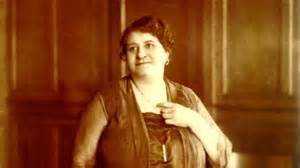Maggie. L Walker was a determined young woman who believed that a person born poor should not die poor. She believed in working hard to uplift her family and the African American community and has been described as a visionary who strived to work not for the present, but for the progress of the future.
She was born on July 15, 1864, in Virginia to Eccles Cuthbert, an Irish American and African American slave Elizabeth Draper. Eccles frequently worked with the Van Lew’s, the family of Elizabeth Van Lew, a spy and abolitionist, where he fell in love with Draper. The two had an affair, and Maggie Lena Walker was born, but Eccles did not marry Elizabeth. About two years after her birth, her mother married Willam Mitchell who worked as a butler on the estate of the Van Lew’s. By this time, Draper had gained her freedom.
In 1876, the body of William Mitchell was found in a river close to his new workplace shortly after the family moved into their new home. At age 12, Maggie had to support her mother by looking after her younger brother, Johnnie and work alongside her as a Laundress. Maggie made the deliveries to their white patrons any time her mother was unable to and helped with housework while her mother toiled tirelessly to sustain the family.
Despite being poor, Draper made sure that her children attended school. Maggie attended Lancaster School and Richmond Colored Normal school. These schools were dedicated to the education of the African- American child. Through hard work and dedication, Maggie excelled in her academics and extracurricular activities.
At the age of 14, Maggie joined the Order of St. Luke, an organisation dedicated to seeing the social and economic rise of the African-American. The organization offered jobs and opportunities to ensure that poverty is erased from the African American community.

Maggie L. Walker teaching a class
She graduated from a teacher training course in 1883 and returned to Lancaster school to teach. Because of her job as a teacher and with the Order of St. Luke, Maggie was able to cater for her family until she met her husband Armstead Walker Jr. whom she married in 1886 and officially became known as Maggie L. Walker.
Armstead Walker was a brick contractor and made enough money to take Maggie and her family out of poverty. It was then that Maggie decided to stop teaching and concentrate on starting a family and her work with the Order of St. Luke.
Even though her husband was well to do, Maggie strived to mark her name in history. She became the grand deputy matron of the Order in 1895 and the Grand Secretary two years later when the Order was bankrupt and on the verge of collapsing. Maggie, who had made a promise to keep it functioning, used her influence to establish a youth arm that would enlighten and inspire the African-American youth to strive for better.

In 1903, Maggie L. Walker founded the St.Luke Penny Savings Bank which was to serve the African-American community and help families save and invest money. She remained the President of the Bank until 1929 when she managed to keep the bank stable and functioning throughout the Great Depression by merging with two other banks. While president of the bank, she made sure that the transactions remained transparent and invested money into institutions to support the Black community. Her position as president of the bank made her the first female of any race in the USA to be president of a bank.
The bank was not the first business that Maggie set up. In 1902, she established the St. Luke Herald, a newspaper with the sole intent to educate the African-American community on happenings around them and important historical events. She later established the St. Luke Emporium department store that provided working opportunities for African Amercian women and provided less expensive good to the Black community in 1905.
In the last years of her life, Maggie had Diabetes. Despite her condition, she continued to work hard until she was confined to a wheelchair. Her son, Russell Walker, was tried for murder after mistaking his father for an intruder and shooting him one evening in 1915. Russell was set free after being found innocent, but the loss of her husband was a pain Maggie nursed for long.
Maggie died at the age of 70 on December 15, 1934.
The Maggie L. Walker Highs School was built in her honour, and her home has since been purchased by the National Parks Service and made a National Historic Site. She was also honoured as one of the first group of Virginia Women in History and her statue by Toby Mendez was unveiled on Broad Street in Richmond in 2017.










